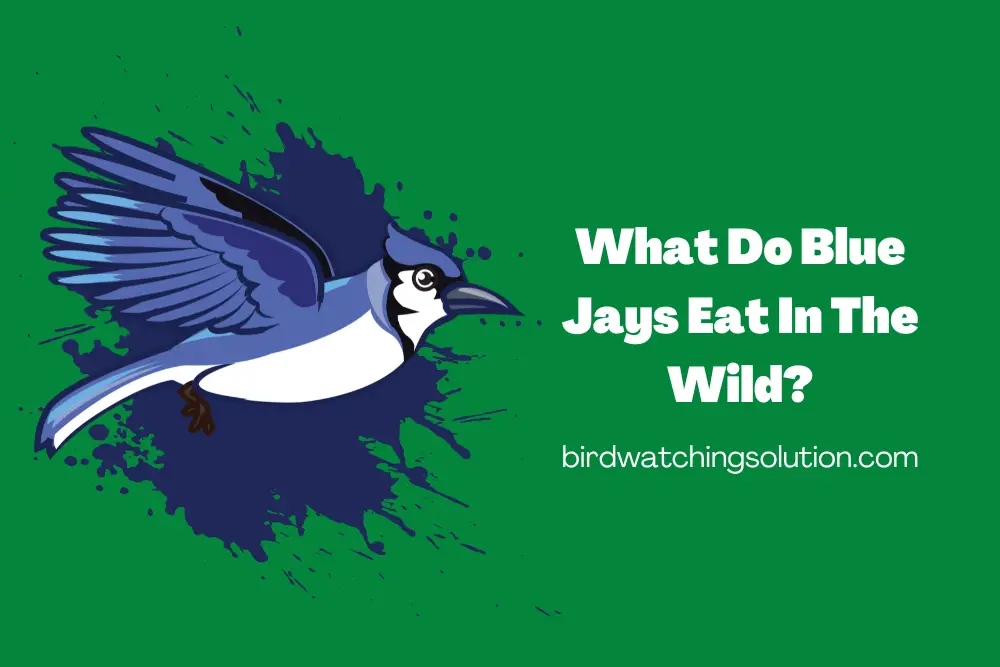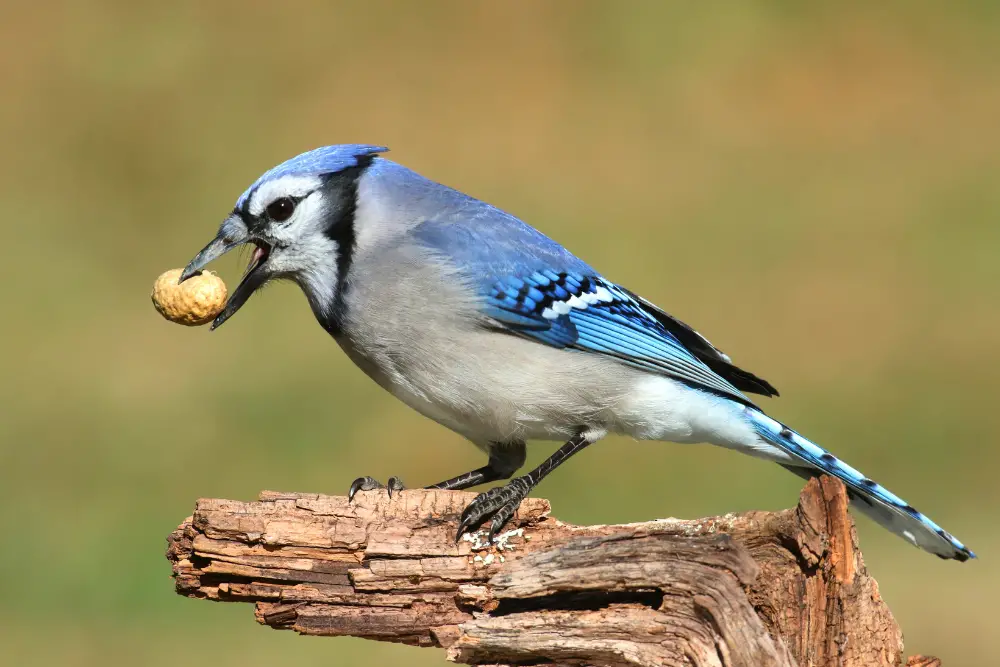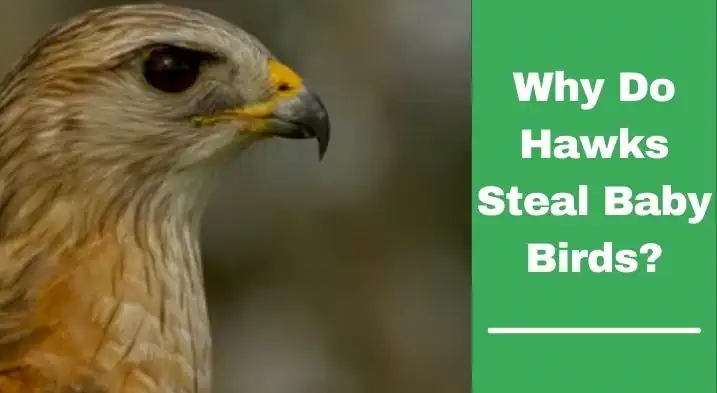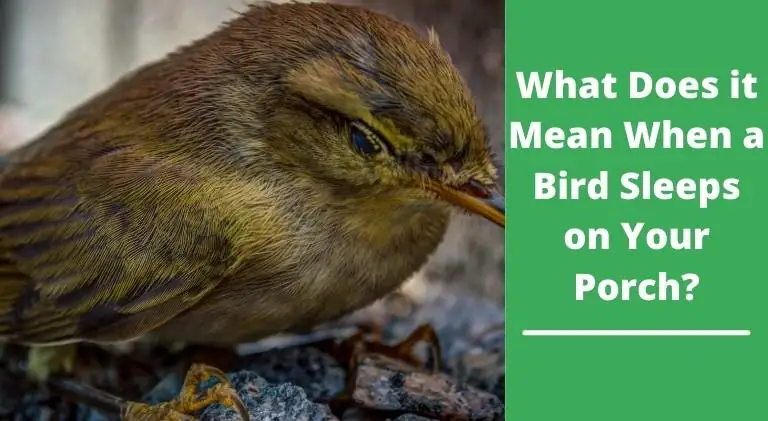What Do Blue Jays Eat In The Wild? A Detailed Guide
Blue jays are one of the most iconic birds found in North America. They are omnivorous, meaning they eat both plants and animals. Blue jays are opportunistic feeders, which means they will take advantage of whatever food is available.
Their diet includes a wide variety of seeds, nuts, fruits, berries, insects, small reptiles and amphibians, and even the eggs or nestlings of other nesting birds! In addition to these foods, blue jays will also scavenge for carrion (dead animal remains) when it’s available.
However, that’s not all and there’s definitely a lot more when it comes to knowing about the diet of blue jays.
Luckily we have covered everything in this article. In addition, we will find out which bird feeders they enjoy the most.

What Do Blue Jays Eat in the Wild?
In the wild, blue jays primarily feed on a variety of seeds, nuts, and fruits. They prefer acorns, but also eat sunflower seeds, corn kernels, peanuts, and other small seeds. They will also visit birdfeeders for a quick snack of peanuts or suet.
Blue jays are not picky eaters when it comes to fruit – they enjoy apples, oranges, cherries, and berries that are growing in backyards and parks.
Insects make up an important part of a blue jay’s diet. They especially enjoy grasshoppers, crickets, caterpillars, and beetles.
Small reptiles like lizards and frogs may also be taken on occasion. To supplement their insect consumption during the winter months, blue jays may also feed on bird eggs or nestlings.
Blue jays will scavenge for carrion if they find it. They also have been known to eat human food like bread crusts and French fries.
Blue Jays’ Foraging And Caching Habits
According to many birdwatchers, Blue Jays have favorable foraging and caching habits. They are known to often store food, such as nuts and seeds, in the ground or in tree crevices to consume later.
This is a common behavior among many members of the Corvid family, which consists of crows, jays, rooks, and ravens.
Blue jays are also known for their impressive acrobatics when searching for food in aerial areas, such as trees and shrubs. These birds use their powerful beaks to rip open pine cones, bark, or even other bird’s nests!
Moreover, blue jays are opportunistic feeders who will search for any type of food that can be found on the ground or in low-lying branches.
They often look for insects, grains, and fruits. When food is scarce, bluejays will turn to stealing from other birds or even raiding bird feeders!
Blue Jays Also Raid Nests and Eat Babies of Small Songbirds
Apart from the above-mentioned food substances blue jays will sometimes raid nests of the other birds. Although they are not specifically looking to eat other birds and their babies but rather to eat their eggs.
However, they often find small nestlings and babies of other birds in the nest and will eat them.
Blue jays have been known to feed on small songbirds like warblers and chickadees, as well as eggs from bluebirds, robins, orioles, and more.
But this predatorial behavior is not common because they are often busy finding their favorite food and insects.

What Do Blue Jays Eat in Summer
Blue jays love hot summer days. This is because, during the summer season, there are usually different types of fruits that they can eat. Besides that their favorite insects come out of the ground usually in search of food during these days.
This allows them to feast on a variety of food substances. They’ll eat just about anything that they can find such as grasshoppers, crickets, and caterpillars.
Blue jays also enjoy small lizards and frogs. Not to mention the fact that they will also raid bird’s nests in search of eggs or baby birds.
Additionally, during summer blue jays will often visit bird feeders for a quick snack of peanuts or suet.
What Do Blue Jays Eat in Winter
In contrast to summer where food is abundantly available almost everywhere the winter season is harsh.
Especially in places like North America region where there is a lot of snow and storms and the temperature drops to freezing levels.
During such situations survival becomes one of the most challenging tasks for birds like blue jays.
During this season most birds migrate to other areas in search of food and to increase their chances of survival.
However, those blue jays who have nests in the gardens and backyards of generous birdwatchers enjoy food from the bird feeders.
Besides that, they would also hunt for food such as berries, nuts, and insects. During winter, blue jays will often raid other birds’ nests to find eggs and nestlings. They may even go so far as to scavenge for carrion if the opportunity arises.
Through a balanced consumption of fruits, nuts, seeds, insects, and the occasional bird egg or nestling – blue jays are sure to have enough food sustenance all year long!
What Do Blue Jays Like on Bird Feeders?
Blue jays love peanuts and suet. They also like sunflower seeds, safflower seeds, corn, and millet. A mix of these foods can be offered in a bird feeder to attract blue jays.
You may want to use a tube-style feeder that has perches and trays for the birds to eat from. Make sure to place the feeder away from the cover so birds don’t hide while eating.
Apart from that, blue jays also love eating peanuts. On one of my backyard bird feeders, I often find them gathering around to eat peanuts. They have a special knack for finding and digging out the peanuts from the bird feeder.
However, some people don’t like blue jays a lot because of their bully nature as they will sometime scare other birds like Cardinals, Finches, and Chickadees away from the feeder.
But I welcome all types of bird species in my backyard and for that purpose, I use the Woodlink 3 in 1 Platform Bird Feeder. This is because being an open feeder it has enough space to accommodate different birds at the same time.
Thus birds of various species can enjoy eating together without fighting with each other for their turns.

Do blue jays eat bananas?
Blue jays prefer eating fruits like apples and berries, as well as insects, small bugs, and small animals.
Occasionally they will eat bananas but it is not a preferred food source for them. It is better to provide them with other foods that they naturally enjoy such as nuts, seeds, and fruit.
If you wish to provide blue jays with a treat occasionally, then you can offer them a banana cut up into smaller pieces. This should be done in moderation though as too much of any one food can be bad for birds.
Do blue jays like fruit?
A lot of beginner birders sometimes ask themselves whether blue jays like fruits or not. The answer to this question is yes!
Blue jays love fruits, especially apples, and berries. They also enjoy eating seeds, nuts, insects, and small animals.
If you want to attract blue jays to your backyard, then it is best to offer them a variety of food sources. A combination of fruits, nuts, seeds, and other food sources will ensure that they have enough sustenance throughout the year.
It is also essential to keep your bird feeders clean regularly and keep the food fresh to attract more birds.
Do blue jays eat rice?
Blue jays are omnivorous birds, which means they eat a variety of foods including insects, seeds, fruits, and sometimes small animals.
While rice is not a natural part of their diet, they may consume it if it is readily available, such as in a bird feeder or in a backyard.
However, it should be noted that rice should not be a staple food for blue jays as it lacks many of the nutrients they need for their overall health.
Frequently Asked Questions
Do blue jays eat apples?
Yes, blue jays do eat apples, especially when they are ripe and readily available. Apples provide a good source of carbohydrates and other nutrients for blue jays. They are also known to eat other types of fruit such as berries, cherries, and grapes.
Do blue jays eat chicken?
While blue jays are opportunistic feeders and may consume small animals such as insects and worms, they are not known to eat chicken. Chicken is not a natural part of their diet and would not provide the necessary nutrients for their overall health.
Do jays eat apples?
Yes, jays including blue jays, Steller’s jays, and other species of jays, do eat apples. Apples provide a good source of carbohydrates and other nutrients for jays. They are also known to eat other types of fruit such as berries, cherries, and grapes.
Do blue jays eat egg shells?
While blue jays may consume small animals and insects, they are not known to eat egg shells. Egg shells do not provide the necessary nutrients for their overall health and are not a natural part of their diet.
Do blue jays eat scrambled eggs?
No, blue jays do not eat scrambled eggs. Despite their omnivorous nature and ability to consume small animals and insects, scrambled eggs are not available to them in the wild.
How much does a blue jay eat a day?
The amount of food a blue jay eats per day varies depending on factors such as the time of year, availability of food, and individual bird metabolism. On average, a blue jay may consume around 2-3 ounces of food per day, which can include a variety of seeds, fruits, and insects.
It’s important to note that providing a varied and balanced diet for blue jays is important for their overall health and well-being.




![Why Do Owls Hoot at Night? [3 Main Reasons]](https://birdwatchingsolution.com/wp-content/uploads/2022/02/Why-Do-Owls-Hoot-at-Night-1.webp)

![Why Do Roosters Crow All Day? – [Discover Facts]](https://birdwatchingsolution.com/wp-content/uploads/2021/10/why-do-roosters-crow-all-day.webp)
